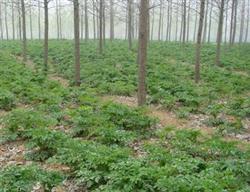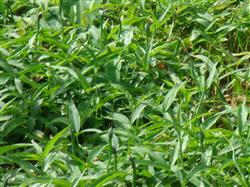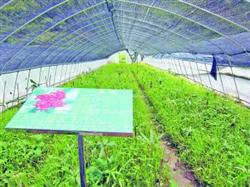Can fruit forests be interplanted with Pinellia ternata?

Can fruit forests be interplanted with Pinellia ternata? Please introduce that dry Pinellia ternata is the most suitable for fruit forest interplanting, because it likes to shade the environment, and the plant is prone to fall seedlings (seedlings withered and yellow and atrophy) in the high temperature season, causing the tuber to stop growing, while the hot summer fruit forest Yemao is the natural protective umbrella during the vigorous growth period of Pinellia ternata, which provides favorable conditions for the normal growth of tubers. Pinellia ternata can be cultivated in the north and south of China, and the medicinal herbs and fruit forests suitable for interplanting are Evodia rutaecarpa, Fructus Aurantii, Gardenia jasminoides, Magnolia officinalis, Eucommia ulmoides, Cortex Phellodendri, Magnolia officinalis, Ginkgo biloba and other woody herbs, as well as citrus, navel orange, peach, pear, jujube, apple, grape and other fruit trees. According to the production situation of our farmers, the income of interplanting Pinellia ternata in every 667m2 (1 mu) fruit forest is about 4000 yuan, which is 33.5 times higher than that of conventional crops. Key points of cultivation techniques 1. Sow seeds. The sowing time is from February to April in spring. Ploughing the land once before sowing (pay attention to keeping a certain distance from the trees when ploughing, do not hurt the roots), combined with ploughing every 667 square meters of fruit forest, apply 100 kg of phosphate fertilizer and 30 kg of compound fertilizer as base fertilizer, and then level and rake fine. shallow ditches are opened side by side with the tree row on the ground, with a ditch distance of 15 cm and a width of 6 cm. Then arrange the tubers in each ditch according to the distance of 10 cm, the tuber bud head up, cover the soil after planting. It is advisable not to see the tuber. two。 Weed. 50% Acetochlor EC should be sprayed in time within one or two days after planting Pinellia ternata tuber, which can inhibit the growth of annual Gramineae weeds. In the plant growth period, if there are many weeds, it can be controlled by Mianxite or 8% high-efficiency herbicide. 3. Fertilize. Due to the dense row spacing of Pinellia ternata, it is inconvenient to topdressing after sowing, therefore, sufficient base fertilizer should be applied. When the seedling height is 20cm, 10kg urea can be used to pour 1000 kg of water (or thin human and animal dung water) on the soil surface every 667m2. 4. Disease prevention. For the first planting of Pinellia ternata, there are few diseases and insect pests, and leaf spot disease and virus disease sometimes occur, which can be controlled with 1 ∶ 1 ∶ 120 Bordeaux solution and 65% Dysen zinc 500 times solution respectively. 5. Harvest. It can be dug 6-7 months after sowing in Pinellia ternata. When the stems and leaves wither and turn yellow, pick up the tubers carefully on a sunny day, shake off the sand, and put them into the basket. After taking it back, separate the fresh tubers according to size, and those less than 1 cm in diameter can be reserved as seeds and stored with wet fine sand. Tubers with a diameter of more than 1 cm are peeled and dried to become a commodity. Click to get more planting techniques of Pinellia ternata
- Prev

How to plant Pinellia ternata?
How to plant Pinellia ternata? Please give a detailed introduction to Pinellia ternata, three-leaf Pinellia ternata, three-step jump, Ma Yuguo, swallow tail, etc. It belongs to Pinellia ternata of Araceae. Pinellia ternata is a commonly used traditional Chinese medicine, with tubers for medicinal purposes, with dryness, dampness and phlegm, anti-vomiting and other functions, raw Pinellia ternata is poisonous. Mainly produced in the provinces of the Yangtze River Basin, now all over the country.
- Next

How to plant Pinellia ternata in greenhouse?
How to plant Pinellia ternata in greenhouse? Please introduce the method of Pinellia ternata, which is the alias of Pinellia ternata, Pinellia ternata, Pinellia ternata and Ma Yuguo, which are commonly used Chinese medicinal materials and are distributed in the north and south of China. In recent years, due to the reclamation and utilization of barren mountains and the extensive use of herbicides in farmland, the ecological environment has been destroyed, resources have been reduced year by year, and the price.
Related
- Fuxing push coffee new agricultural production and marketing class: lack of small-scale processing plants
- Jujube rice field leisure farm deep ploughing Yilan for five years to create a space for organic food and play
- Nongyu Farm-A trial of organic papaya for brave women with advanced technology
- Four points for attention in the prevention and control of diseases and insect pests of edible fungi
- How to add nutrient solution to Edible Fungi
- Is there any good way to control edible fungus mites?
- Open Inoculation Technology of Edible Fungi
- Is there any clever way to use fertilizer for edible fungus in winter?
- What agents are used to kill the pathogens of edible fungi in the mushroom shed?
- Rapid drying of Edible Fungi

